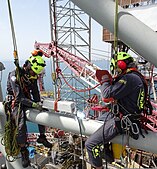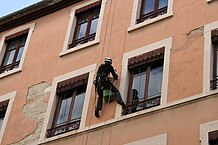 Window cleaning Portside Tower
Window cleaning Portside Tower Repairing on oil platforms and rigs in Iran
Repairing on oil platforms and rigs in Iran Cleaning a clock
Cleaning a clock Carrying out maintenance work on the facade of a building
Carrying out maintenance work on the facade of a building
Rope access or industrial climbing or commercial climbing, is a form of work positioning, initially developed from techniques used in climbing and caving, which applies practical ropework to allow workers to access difficult-to-reach locations without the use of scaffolding, cradles or an aerial work platform. Rope access technicians descend, ascend, and traverse ropes for access and work while suspended by their harnesses. Sometimes a work seat may be used. The support of the rope is intended to eliminate the likelihood of a fall altogether, but a backup fall arrest system (Personal protective equipment) is used in case of the unlikely failure of the primary means of support. This redundancy system is usually achieved by using two ropes - a working line and a safety line.
See also
References
- "Rope Access | SPRAT". Retrieved 2021-04-23.
- "What is Rope Access | IRATA International". www.irata.org. Retrieved 2021-04-23.
External links
- IRATA International - Industrial Rope Access Trade Association
- IRATA International Code of Practice (ICOP)
- SPRAT - The Society of Professional Rope Access Technicians
- SPRAT Safe Practices for Rope Access Work
- ISO 22846 - International Standard for Rope Access